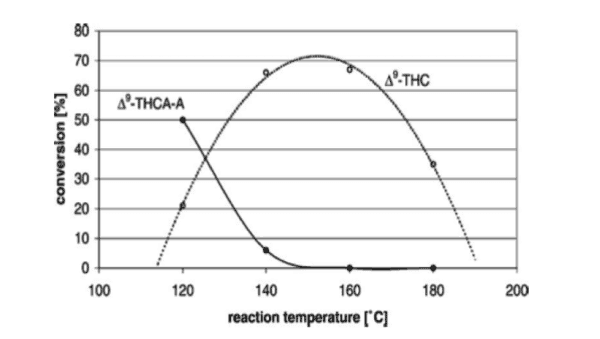It’s Sunday evening. You’re a first time patient hoping to experiment with making cannabis infused edible preparations. After reading information online, you’ve decided on a recipe and selected the right cannabis strain. You patiently mix and time the baking; the product emerges from the oven and has a distinct herbal taste. Time passes as you wait for the medicine to take effect. Yet, several hours later, no effect or attenuation of the symptoms you are seeking relief from has arrived. …What happened? Why was the preparation unsuccessful?
Unfortunately, almost every patient who has experimented with making cannabis infused edible preparations can attest to the need for careful temperature observation during extraction and cooking. This is a result of the chemical process that is necessary for THC to be available for use by the body. As it turns out, much of the THC naturally available in cannabis is actually originally produced in the form THCA or tetrahydrocannabinolic acid. This molecule is the standard THC molecule with the addition of a carboxyl group, which is a molecule composed of carbon, oxygen, and hydrogen. Although this addition seems relatively minor to the structure, it has a very significant impact on the ability for the body to use THC, as it blocks the molecule from binding with cannabinoid receptors in the brain.
Cannabis prepared for ingestion must first undergo a decarboxylation process to convert the molecule to normal, usable THC. The method for this process requires giving the THCA molecule extra energy, in the form of heat, that allows the carboxyl group to escape. The resultant release is usually in the form of CO2 and water. With edibles, this heat is applied via cooking. With smoking or vaporizing, the necessary heat is generated by flame or heating element.
When THCA began to be commercially available in the early 2000’s, the Institute of Legal Medicine in Switzerland began to search for a more convenient way to extract THCA. During this process, the group was left with large amounts of raw THCA, with which they were able to experiment with the decarboxylation of THCA and formation of THC. One interesting result to emerge from this experiment is that researchers were able to establish the most optimal temperature for THCA to THC conversion. The researchers accomplished this by measuring levels of THC within a specified amount of THCA while gradually applying heat, producing the graph below:
As seen, the issue is not so simple as “increasing temperature increases THCA to THC conversion”. After a certain point, THC observed begins to disappear. This is because at certain temperatures, some of the THC molecules begin to oxidize to form cannabinol (CBN), a non-psychoactive cannabinoid. However, due to the nature of the chemical reactions taking place, THC begins oxidizing to CBN before all of the THCA contained in a sample can be converted to THC. The two reactions are occurring simultaneously. This is important to note for two reasons:
- It is therefore impossible to successfully convert to THC, all THCA from a given sample. In this research group’s experiment, the highest conversion rate was revealed to be around 70%. Although some cannabis dispensaries add THC and THCA amounts together as the total amount of THC listed within a sample, this is simultaneously accurate and misleading. Consumers armed with knowledge of the behavior of THCA as a precursor will be able to more easily estimate the effect of the THCA contained within a given sample.
- This explains why creating cannabis edibles can be so sensitive; although heat is needed for decarboxylation, heat over 150 degrees Celsius (~300 degrees Fahrenheit) will begin to also degrade the THC. To attain the maximum potency of medicine with the least residual THCA or CBN, bakers must aim for temperatures around 140-160 Celsius.
However, while THCA alone is not psychoactive, it is not without medical benefit. In fact, a study from the University of Guelph found last year that THCA could be helpful in preventing anticipatory nausea. Anticipatory nausea is nausea produced by the body in response to environmental factors or stimuli that have been associated with or caused discomfort or sickness in the past. Individuals who have become sick from consuming too much alcohol, for instance, may find themselves nauseous upon smelling the same type or brand of alcohol as consumed prior. Likewise, cancer patients receiving chemotherapy may begin to feel nauseous when entering the same room of administration. In this study, researchers trained rodents to develop anticipatory nausea by administering lithium chloride to rodents to induce nausea along with a specific flavoring that the rodents would learn to associate with that nausea. Later, the researchers applied the same flavoring to a solution of THCA before administering it to the rodents, as well as a solution without THCA but again with the flavoring, to note what differences would occur. The researchers then measured time and frequency of mouth “gaping”, which is indicative of nausea in rodents. As expected, the mice without THCA responded to the flavor with nausea, their bodies expecting lithium chloride to also be present and thus preparing for the reaction. However, the groups of rodents treated with THCA showed strong resistance to this conditioned nausea.
The over-heating of THC that causes its oxidation and ultimate degradation to cannabinol is the likely culprit behind many failed edibles. Yet without applying heat, much of the potential THC will remain as non-psychoactive THCA. THCA has however been proven to be a valuable molecule of consideration for medicinal benefit specifically for those dealing with nausea.
Works Cited:
Franz E. Dussy, Cornelia Hamberg, Marco Luginbuhl, Thomas Schwerzmann, and Thomas A. Briellmann. (2005) Isolation of Delta-9-THCA-A from help and analytical aspects concerning the determination of delta-9-THC in cannabis products. Forensic Science International 149 (2005) 3-10.
M.Rock, Cheryl L. Limebeer, Roshan Navaratnam, et. al. (2013) A comparison of cannabidiolic acid with other treatments for anticipatory nausea using a rat model of contextually elicited conditioned gaping. Psychopharmacology (2014)


